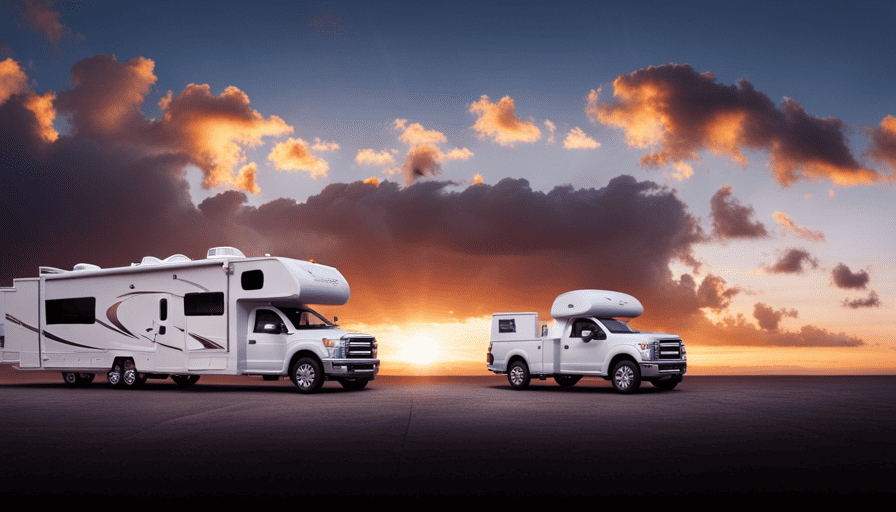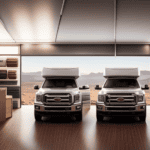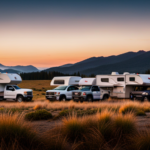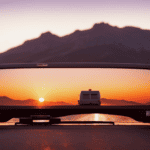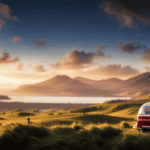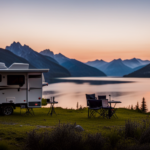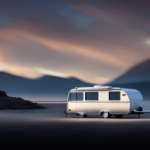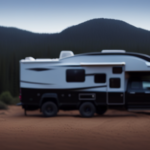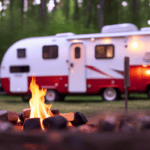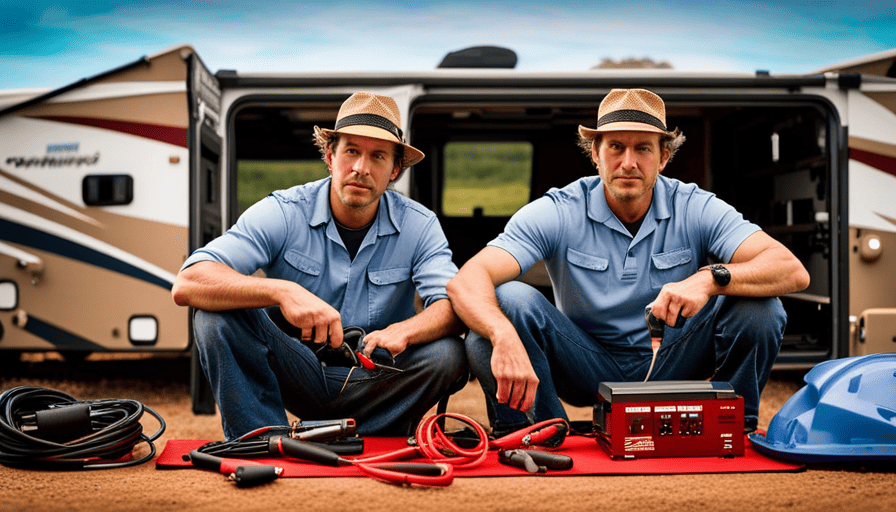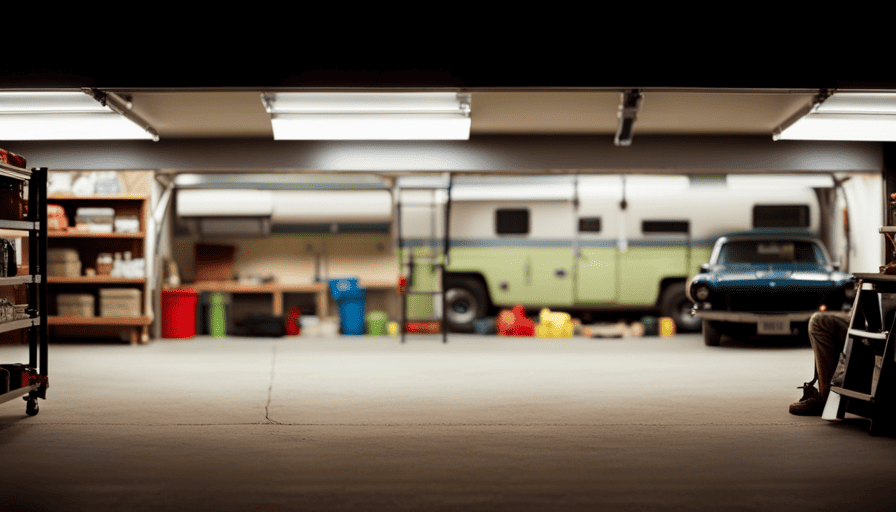Are you eager to begin an amazing adventure, traveling along scenic highways in search of breathtaking views and unforgettable experiences? Look no further than the convenient and versatile option of a truck camper. But before you set your sights on the horizon, one important question arises: how much does a truck camper cost?
Truly, the answer varies greatly depending on several factors. From the size and type of camper to the brand and quality, there are numerous elements that contribute to the overall price tag. Furthermore, the decision between a new or used camper, as well as the inclusion of additional accessories and add-ons, can significantly impact the final cost.
However, fear not, as this article aims to unravel the mystery and shed light on the considerations and nuances that come with pricing a truck camper. So buckle up, fellow adventurers, as we dive into the world of truck campers and uncover the secrets behind their cost.
Key Takeaways
- Truck campers come in different sizes and types with materials like aluminum, fiberglass, and wood.
- Kitchenettes, bathroom facilities, and storage compartments are common features found in truck campers.
- There are basic and luxury options available, with luxury campers offering additional comforts and conveniences.
- Popular manufacturers include Lance, Arctic Fox, and Four Wheel Campers, each known for their unique qualities and features.
Different Sizes and Types of Truck Campers
Truck campers come in various sizes and types, allowing for customization and catering to individual needs. When it comes to choosing the right truck camper, it’s important to consider different factors such as materials and weight considerations.
One of the key aspects to consider is the material used in the construction of the camper. Truck campers can be built with different materials, including aluminum, fiberglass, and wood. Each material has its own advantages and disadvantages. Aluminum is lightweight and durable, while fiberglass offers better insulation and is less prone to damage. On the other hand, wood provides a classic look but may require more maintenance over time.
Weight considerations are also crucial when selecting a truck camper. The weight of the camper can impact the overall performance of your truck, including fuel efficiency and towing capacity. It’s important to ensure that the weight of the camper is within the recommended limits of your truck.
Moving on to the next section about features and amenities, truck campers offer a wide range of options to enhance your camping experience. From spacious sleeping areas and kitchenettes to bathroom facilities and storage compartments, these features can greatly improve your comfort and convenience on the road.
Features and Amenities
When it comes to truck campers, there are a range of features and amenities to consider. From basic to luxury options, there is something for every camper’s preference and budget.
The kitchen and bathroom facilities vary as well, with some campers offering compact yet functional setups, while others provide more spacious and luxurious options.
Additionally, the sleeping and storage options can vary greatly, with some campers offering multiple sleeping areas and ample storage space.
Basic vs. luxury features
Although it may seem like a fortune, you’ll be amazed at the price difference between a truck camper with basic features and one with luxurious amenities. When it comes to truck campers, there are options available for every budget and preference.
Basic features typically include a comfortable sleeping area, storage space, and basic kitchen facilities. These campers are designed to provide the essentials without breaking the bank.
On the other hand, luxury options offer additional comforts and conveniences such as air conditioning, heating systems, entertainment systems, and high-end furnishings. The price difference between these options can be substantial, with luxury campers costing significantly more.
However, it’s important to note that customization options are available for both basic and luxury campers, allowing you to tailor the features to your specific needs and preferences.
Moving on to the kitchen and bathroom facilities…
Kitchen and bathroom facilities
The kitchen and bathroom facilities in a truck camper can really enhance your camping experience. When it comes to kitchen appliances, most truck campers come equipped with a compact yet functional kitchenette. This typically includes a stove, a sink, and a small refrigerator. Some higher-end models may even have a microwave or an oven.
The bathroom layout in a truck camper usually consists of a compact toilet, a shower, and a sink. While the size may be smaller compared to a traditional bathroom, they’re designed to maximize space and functionality. The bathroom may also come with storage cabinets for toiletries and towels.
Moving on to the next section about sleeping and storage options, it’s important to consider the layout and design of the camper to ensure maximum comfort and convenience.
Sleeping and storage options
If you’re looking for a cozy and efficient way to rest and organize your belongings, you’ll be pleased with the sleeping and storage options in a truck camper. These campers are designed with truck owners in mind, and as such, they offer a range of customization options to maximize space efficiency.
From fold-down beds to bunk beds, there are various sleeping arrangements available to suit your needs. Additionally, truck campers are equipped with ample storage solutions, including cabinets, drawers, and under-bed compartments, allowing you to keep your belongings organized and easily accessible.
Whether you’re traveling solo or with a group, these sleeping and storage options ensure that you can make the most of the available space in your truck camper. Moving on to the next section about ‘brand and quality,’ it’s important to consider these factors when choosing the right truck camper for you.
Brand and Quality
When it comes to choosing a truck camper, the brand and quality are important factors to consider.
There are several popular truck camper manufacturers in the market, each with their own unique features and designs.
Reputation and customer reviews play a crucial role in determining the overall quality and reliability of a truck camper.
Lastly, the warranty and after-sales support provided by the manufacturer can give you peace of mind knowing that you’ll be taken care of in case of any issues or concerns.
Popular truck camper manufacturers
To find the best truck camper for your needs, you should check out popular manufacturers like Lance, Arctic Fox, and Four Wheel Campers. These companies have consistently ranked high in terms of popularity and customer satisfaction.
Here is a list of reasons why they are so well-regarded:
-
Lance: Known for their durable construction and innovative features, Lance truck campers are a top choice among outdoor enthusiasts.
-
Arctic Fox: With a focus on quality and comfort, Arctic Fox campers are renowned for their insulation and ability to withstand extreme weather conditions.
-
Four Wheel Campers: Offering a lightweight and compact design, Four Wheel Campers are perfect for off-road adventures, providing convenience and versatility.
-
Customer Reviews: These manufacturers have gained a solid reputation due to positive feedback from satisfied customers.
With this knowledge about their reputation and customer reviews, let’s delve into the next section about the importance of considering the camper’s brand and quality.
Reputation and customer reviews
After exploring popular truck camper manufacturers, it is important to consider their reputation and customer reviews. Reputation management plays a vital role in the success of any business, and truck camper manufacturers are no exception. Customer satisfaction is a key indicator of a company’s reputation, as happy customers are more likely to recommend a brand to others. By examining customer reviews, we can gain valuable insights into the overall quality and performance of truck campers offered by different manufacturers. This feedback allows us to make informed decisions and choose a brand that aligns with our needs and preferences. To further evaluate the manufacturers, I have created a table below comparing their reputation and customer satisfaction ratings based on online reviews and industry feedback. Understanding the reputation and customer experiences is crucial in selecting the best truck camper brand for our needs.
| Manufacturer | Reputation | Customer Satisfaction |
|---|---|---|
| Brand A | High | 4.5/5 |
| Brand B | Medium | 3.8/5 |
| Brand C | Low | 3.2/5 |
Now that we have an understanding of the manufacturers’ reputations and customer satisfaction, let’s delve into the important topic of warranty and after-sales support.
Warranty and after-sales support
Additionally, considering the warranty and after-sales support provided by each manufacturer is crucial in ensuring a seamless ownership experience and addressing any potential issues that may arise with the truck camper.
When researching truck campers, it’s important to understand the warranty coverage offered by the manufacturer. This includes the duration of the warranty, what specific components are covered, and any limitations or exclusions. A comprehensive warranty can provide peace of mind and protect your investment.
Equally important is the level of customer service provided by the manufacturer. Responsive and helpful customer service can make a big difference when it comes to resolving any concerns or questions that may arise during your ownership. By thoroughly researching the warranty coverage and customer service reputation of different manufacturers, you can make an informed decision and ensure a positive ownership experience.
Moving on to the next section about ‘new vs. used campers’, it’s important to consider the pros and cons of each option.
New vs. Used Campers
When considering the purchase of a truck camper, it’s important to weigh the options between buying new or used.
First and foremost, cost is a major factor. New campers tend to have a higher price tag, while used campers can offer significant savings.
However, there are pros and cons to both options. Buying new ensures you’re getting the latest features and warranties, but buying used allows for potential negotiation and the chance to find a camper with a proven track record.
When inspecting a used camper, it’s crucial to thoroughly examine its condition, inside and out, checking for any signs of damage or wear and tear.
Price comparison of new and used campers
To get the best bang for your buck, consider exploring the enchanting world of truck campers, where new and used options dance together in a mesmerizing price waltz.
When it comes to cost comparison, buying new or used can have its advantages and disadvantages. Here’s a breakdown of what you can expect:
- New Campers:nnPros:
- The latest features and technologies
- Warranties for peace of mind
Cons:
-
Higher upfront cost
-
Depreciation as soon as you drive off the lot
-
Used Campers:nnPros:
-
Lower initial cost
-
Less depreciation
Cons:
- Potential wear and tear
- Limited warranty options
Considering these factors, it’s important to weigh the pros and cons of buying new or used before making a decision. As we delve into the next section about the pros and cons of buying new or used, we’ll explore these aspects in more detail.
Pros and cons of buying new or used
If you’re torn between buying new or used, let’s weigh the pros and cons of each option. When it comes to purchasing a truck camper, there are advantages and disadvantages to both new and used models.
Buying a new camper offers the advantage of being in pristine condition with the latest features and technology. You also have the peace of mind knowing that it comes with a warranty. However, new campers tend to be more expensive and may depreciate quickly.
On the other hand, buying a used camper can save you money upfront and may have already gone through any initial depreciation. However, you might inherit someone else’s wear and tear issues, and there may be limited warranty options available.
To help you visualize the pros and cons, here’s a table comparing new and used campers:
| New Camper | Used Camper |
|---|---|
| Pristine condition | Potential wear and tear |
| Latest features and technology | Limited warranty options |
| Higher price | Potential savings on upfront cost |
| Depreciation over time | Potential for initial depreciation |
Considering these factors, you can make an informed decision based on your budget and preferences. Now, let’s move on to the next section about tips for inspecting a used camper.
Tips for inspecting a used camper
Ready to hit the road in a used camper? Let’s explore some valuable tips for inspecting it to ensure you make a smart and informed purchase decision.
When evaluating the condition of a used truck camper, it’s important to thoroughly inspect both the interior and exterior. Start by checking for any signs of water damage, such as soft spots on the floor or walls, as this can indicate potential issues. Look for any signs of wear and tear on the furniture, appliances, and fixtures.
It’s also crucial to inspect the roof for any cracks or leaks. Don’t forget to examine the exterior for any dents, scratches, or rust. By paying close attention to these details, you can uncover any hidden damages and avoid expensive repairs down the road.
Now, let’s move on to exploring additional accessories and add-ons for your truck camper.
Additional Accessories and Add-ons
Get ready to deck out your truck camper with extra accessories and add-ons that’ll transform it into a road warrior’s dream machine. When it comes to accessory options, the possibilities are endless.
From practical additions like awnings and bike racks to luxurious upgrades like solar panels and entertainment systems, there’s something for everyone. Before diving headfirst into the world of accessories, it’s important to consider the cost. Prices can vary greatly depending on the brand, quality, and complexity of the add-on. It’s essential to set a budget and prioritize which accessories are must-haves.
While some accessories may seem expensive upfront, they can greatly enhance your camping experience and add value to your truck camper. As you explore the wide range of accessory options, keep in mind that not all add-ons are compatible with every truck camper. Some modifications may be necessary to ensure proper installation and functionality.
In the next section, we’ll delve into truck compatibility and modifications required to accommodate different accessories.
Truck Compatibility and Modifications
Make sure your truck is compatible and prepared for modifications to accommodate the wide range of accessories and add-ons available for your truck camper. Here are some important truck modifications and compatibility considerations to keep in mind:
-
Payload Capacity: Check your truck’s payload capacity to ensure it can handle the additional weight of the camper and any modifications. This includes considering the weight of passengers, gear, and other items you plan to carry.
-
Suspension Upgrades: Upgrading your truck’s suspension can improve its ability to handle the added weight and provide a smoother ride. Consider options such as heavy-duty shocks, airbags, or helper springs.
-
Towing Capacity: If you plan to tow a trailer or other equipment along with your camper, make sure your truck has the necessary towing capacity. Consult your vehicle’s towing specifications and consider any necessary upgrades like a towing package or trailer brake controller.
-
Bed Modifications: Depending on the type of camper you choose, you may need to make modifications to the truck bed. This can include installing tie-downs, bed extenders, or even reinforcement for increased stability.
Ensuring your truck is compatible and properly modified for your camper is essential for a safe and enjoyable experience. Now, let’s move on to insurance and financing considerations.
Insurance and Financing Considerations
When considering truck compatibility and modifications for a truck camper, it’s important to also take into account insurance and financing considerations. These factors can have a significant impact on the overall cost of owning a truck camper.
Insurance coverage is crucial to protect your investment. It’s essential to find an insurance policy that provides adequate coverage for your truck camper, including liability, collision, and comprehensive coverage. The cost of insurance can vary depending on factors such as the value of your camper, your driving record, and the area where you live. It’s a good idea to shop around and compare quotes from different insurance providers to ensure you’re getting the best coverage at the most affordable rate.
Financing is another important consideration when purchasing a truck camper. If you’re not able to pay for the camper outright, you may need to finance the purchase. Loan interest rates can vary depending on your credit score, the amount of the loan, and the length of the loan term. It’s important to research and compare different financing options to find the best rate and terms for your situation.
Considering insurance coverage and loan interest rates will help you better understand the total cost of owning a truck camper. Now, let’s explore another way to save money on your truck camper purchase: seasonal discounts and sales.
Seasonal Discounts and Sales
One way to save money on your truck camper purchase is by taking advantage of seasonal discounts and sales. Many truck camper manufacturers and dealers offer special promotions and limited-time offers throughout the year to entice buyers and boost sales. These discounts can range from a percentage off the total price to free upgrades or accessories.
To find out about these deals, it’s a good idea to sign up for newsletters or follow the social media accounts of truck camper manufacturers and dealerships. They often send out discount codes or announce upcoming sales events.
Seasonal discounts and sales can significantly reduce the cost of a truck camper, allowing buyers to get a high-quality camper at a more affordable price. However, it’s important to do thorough research and compare prices from different dealerships to ensure you’re getting the best deal possible. Keep in mind that these discounts are often for a limited time only, so it’s crucial to act quickly when you come across a deal that fits your budget and preferences.
Speaking of the budget, the next section will discuss the importance of considering resale value and depreciation when purchasing a truck camper.
Resale Value and Depreciation
Considering the resale value and depreciation of a truck camper is essential when making a purchasing decision. It is important to understand how these factors can affect the overall cost of owning a truck camper over time. To conduct a thorough resale value analysis, several factors need to be taken into account. These include the brand and model of the camper, its age and condition, and the current market demand for truck campers. Additionally, factors affecting depreciation include mileage, wear and tear, and any modifications or upgrades made to the camper.
To provide a more comprehensive understanding of the potential resale value and depreciation of a truck camper, I have created a table outlining different scenarios:
| Scenario | Resale Value | Depreciation |
|---|---|---|
| Excellent Condition | $25,000 | $5,000 |
| Good Condition | $20,000 | $10,000 |
| Fair Condition | $15,000 | $15,000 |
As shown in the table, the resale value and depreciation can vary depending on the condition of the truck camper. It is important to keep in mind that these values are just estimates and can vary based on individual circumstances.
Understanding the potential resale value and depreciation of a truck camper can help in budgeting and assessing its affordability in the long run. By considering these factors, you can make a more informed decision about purchasing a truck camper that aligns with your financial goals.
Budgeting and Affordability
When it comes to purchasing a truck camper, it’s essential to determine your budget and financial readiness. This involves evaluating your current financial situation and determining how much you can comfortably afford to spend on a camper.
Additionally, exploring financing options and monthly payments can help ensure that the purchase fits within your budget.
Lastly, it’s crucial to evaluate the long-term cost of ownership, including maintenance, insurance, and potential depreciation, to make an informed financial decision.
Determining your budget and financial readiness
To figure out if you’re financially ready for a truck camper, you should start by determining your budget and how much you’re willing to spend. Evaluating affordability and engaging in financial planning are crucial steps in this process.
Consider your current financial situation, including your income, expenses, and any existing debt. Determine how much you can comfortably allocate towards purchasing a truck camper without jeopardizing your financial stability. It’s important to be realistic and honest with yourself about what you can afford.
Research the average cost of truck campers in the market and compare it to your budget. This will give you a better idea of whether you need to adjust your expectations or if you’re in a good position to make a purchase.
Understanding your budget and financial readiness is the first step towards finding the right truck camper for you. When you have a clear understanding of your financial situation, you can then explore financing options and monthly payments.
Financing options and monthly payments
If you’re looking to purchase a truck camper, you’ll be pleased to know that there are various financing options available to help make your dream a reality. Financing a truck camper allows you to spread out the cost over time, making it more affordable and manageable. When exploring financing options, it’s important to consider interest rates, as they can greatly impact the overall cost of your camper. To help you understand the potential monthly payments, I’ve created a table below outlining different financing terms and corresponding interest rates:
| Financing Term | Interest Rate |
|---|---|
| 5 years | 4.5% |
| 10 years | 5.2% |
| 15 years | 6.0% |
| 20 years | 6.5% |
By comparing these options, you can determine the most suitable financing term for your budget. Once you have a clear understanding of your monthly payments, you can move on to evaluating the long-term cost of ownership.
Evaluating the long-term cost of ownership
Consider the long-term expenses involved in owning a truck camper, and let the reality of maintenance, insurance, and campground fees sink in. Evaluating the cost effectiveness of a truck camper requires taking into account the long-term maintenance costs.
Regular maintenance and repairs are essential to keep the camper in good condition and prevent any major issues down the line. This includes routine inspections, oil changes, tire rotations, and other necessary upkeep.
Additionally, insurance costs should be factored in, as they vary depending on the value and type of camper.
Lastly, campground fees can add up over time, especially if you plan to use your truck camper frequently. It’s important to consider all these factors when evaluating the long-term cost of ownership and determining whether a truck camper is a viable option for you.
Frequently Asked Questions
Can I customize the layout and design of a truck camper to fit my specific needs and preferences?
Absolutely! When it comes to truck campers, you can customize the layout and design to fit your specific needs and preferences. You have a plethora of options to tailor the layout and design. From choosing the number of beds to the kitchen configuration, you can have it all. The design flexibility of truck campers ensures that you can create a personalized space that perfectly suits your camping adventures.
Are there any additional costs associated with owning a truck camper, such as maintenance, storage, or campground fees?
There are indeed additional costs associated with owning a truck camper. Firstly, there are maintenance costs to consider, such as regular servicing, repairs, and any necessary upgrades.
Additionally, storage options must be taken into account, as you’ll need a secure and suitable place to keep your camper when it’s not in use.
Depending on your location, you may also incur campground fees if you choose to stay at campsites during your travels.
What are the main factors that affect the resale value and depreciation of a truck camper?
When considering the resale value and depreciation of a truck camper, several factors come into play.
One interesting statistic to note is that on average, truck campers depreciate by about 20% in the first year alone.
Resale value factors include the brand reputation, condition of the camper, and any upgrades or modifications made.
Depreciation factors include mileage, age, and overall market demand.
It’s important to keep these factors in mind when buying a truck camper.
Are there any specific regulations or requirements for operating a truck camper, such as weight restrictions or license endorsements?
Weight restrictions and license endorsements are important considerations when operating a truck camper. Depending on your location, there may be specific regulations regarding the maximum weight allowed for truck campers.
It’s crucial to ensure that your truck camper doesn’t exceed the weight restrictions set by your state or country. Additionally, some areas may require you to have a special license endorsement to operate a truck camper. So, it’s essential to check the local requirements before hitting the road.
What are some common mistakes or pitfalls to avoid when purchasing a truck camper?
When it comes to purchasing a truck camper, there are some common mistakes that buyers should avoid.
Firstly, it’s important to thoroughly research and understand the weight restrictions and requirements of your specific truck model.
Additionally, be sure to inspect the camper thoroughly for any signs of damage or wear.
It’s also advisable to test out the camper’s features and functionality before making a purchase.
Lastly, consider your camping needs and preferences to ensure that the camper meets your requirements.
Are Scamp Campers More Expensive Than Truck Campers?
Scamp camper pricing is a major factor when comparing it to truck campers. Scamp campers tend to be more affordable, making them a cost-effective choice for outdoor enthusiasts. While truck campers offer some advantages, their pricing can be higher due to larger size and additional amenities. Ultimately, it boils down to personal preferences and budget when deciding between the two.
Conclusion
In conclusion, truck campers come in a wide range of prices depending on various factors such as size, type, brand, and quality. It’s important to consider features, amenities, and additional accessories when determining the cost.
While new campers may be more expensive, they offer the advantage of customization and warranty. On the other hand, used campers may be more affordable but require thorough inspection.
An interesting statistic to note is that, according to a recent study, the average cost of a new truck camper is around $25,000.

